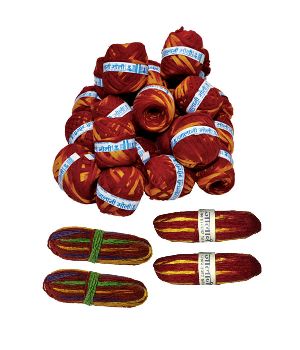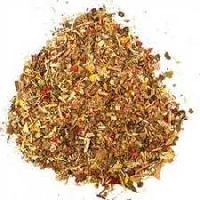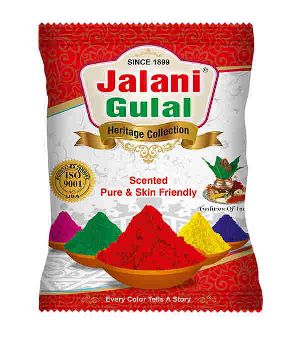
Jalani Hanuman sindoor
Orange color Jalani Hanuman sindoor (vermilion) is Beneficial for evil eye, fears, spirit and haunted place. Lord Hanuman applied Sindoor on his body in order to please Lord Rama, Applying Jalani sindoor pleases Hanuman and gives strength, protection from evil eyes and makes the worshipper fearless.. In India, whenever people visit temples they dip their finger in sindoor and apply a dot or tilak on their necks or forehead or between eye brows. Sindoor is not just used by the womenfolk of India. Even men, boys, girls and little children apply a dot of this powder or past on their forehead when they visit a temple or attend some religious function. A traditional component of the sindoor is powdered red lead and other ingredients. Make a thick past of Jalani sindoor with chameli (jasmine) oil, chandan (Sandal) oil or any other kind of oil or Ghee (Butter Vax). With the ring finger of the right hand, Jalani Sindoor can be applied to Lord Hanuman, bheru and Ganesh/Ganpati daily worship.
...more
pooja samagri

Kumkum
Kumkum is a powder used for social and religious markings in Hinduism. It is made from dried turmeric and powdered with Natural ingredients without any chemical to make pure and red rich colored Kumkum or Roli. Most of the kumkum available in market are made from synthetic dyes, filler materials, lime and salts of lead and mercury to provide fast and brilliant red shades which is harmfull for human body. Jalani kumkum made from pure turmeric Powder (Haldi) without any harmfull chemicals.
...more
kalava
What is Moli/ Mouli / Kalava? Moli is a 100% cotton thread, it’s red thread roll and it has small yellow parts in between the red string. Normally moli, which is available in the market, does not contain good quality of colors and it leaves color on the cloths as well on the skin. Today the time is change, Jalani Traders introduces a scientific made good quality of moli, which is made up of 100 % pure cotton with use of superior color quality. Jalani moli considered being very sacred and used in all religious purposes of the Hindus. Traditional use of Moli / Mouli / Kalava Jalani Moli is used as an offering of cloth to the deity. It is worn while performing Hindu rituals like Yajna and Puja. Jalani Mouli thread is an integral part of any puja. Normally Jalani Mouli is tied before the start of the puja, Jalani Mouli thread is tied around the wrist of the members of the family and all those who attend the prayer ceremony. As a rule all males and married females wear it on the right hand. Unmarried females wear it on their left hands. The basic significance of wearing Jalani Mouli is to get blessings from God. Historical aspect of Moli Since ancient time people like to ware moli on their wrist, neck & waist as a good luck charm or as a culture. As per the tradition, on any occasion like house and office inauguration, purchase of any kind of vehicle, home and office appliances we tied moli on that. Moli is tie on the appliance for their safety and long running life. Benefits of Wearing moli • From the ancient time vaid (Indian tradition Doctor) believe that our whole body is control by the wrist nerve (Vein) so if we wear moli on the wrist, it help to control the whole body blood circulation. • Now days Doctor’s suggest to wear a belt on wrist to control the blood pressure. But old people believe that wearing Moli is more effective than belt. They always gave suggestion to tie moli on wrist 6 to 7 rounds to control the blood pressure level. • Every mother wants to keep their child away from any social insecurity (does not seem so evil), so they like to tie moli on their child’s wrist, neck & waist. • Traditionally we are using moli in the temple & mosque as a “mannat ka dhaaga” (Votive Thread). Moli Make Relation Good Moli tied by sister to his brother’s hand at happiest occasion of “Rakha Bhandan” for "mangalkamna". In marriage ceremony moli tied the married couple with each other. Today Moli is tie by people on their hand as fashion and dharmik Astha. Moli also offered by one friend to other friend on Friendship Day. Even it’s a fact that we are using moli on every moment of our life since birth till death. What is Moli/ Mouli / Kalava? Moli is a 100% cotton thread, it’s red thread roll and it has small yellow parts in between the red string. Normally moli, which is available in the market, does not contain good quality of colors and it leaves color on the cloths as well on the skin. Today the time is change, Jalani Traders introduces a scientific made good quality of moli, which is made up of 100 % pure cotton with use of superior color quality. Jalani moli considered being very sacred and used in all religious purposes of the Hindus. Traditional use of Moli / Mouli / Kalava Jalani Moli is used as an offering of cloth to the deity. It is worn while performing Hindu rituals like Yajna and Puja. Jalani Mouli thread is an integral part of any puja. Normally Jalani Mouli is tied before the start of the puja, Jalani Mouli thread is tied around the wrist of the members of the family and all those who attend the prayer ceremony. As a rule all males and married females wear it on the right hand. Unmarried females wear it on their left hands. The basic significance of wearing Jalani Mouli is to get blessings from God. Historical aspect of Moli Since ancient time people like to ware moli on their wrist, neck & waist as a good luck charm or as a culture. As per the tradition, on any occasion like house and office inauguration, purchase of any kind of vehicle, home and office appliances we tied moli on that. Moli is tie on the appliance for their safety and long running life. Benefits of Wearing moli • From the ancient time vaid (Indian tradition Doctor) believe that our whole body is control by the wrist nerve (Vein) so if we wear moli on the wrist, it help to control the whole body blood circulation. • Now days Doctor’s suggest to wear a belt on wrist to control the blood pressure. But old people believe that wearing Moli is more effective than belt. They always gave suggestion to tie moli on wrist 6 to 7 rounds to control the blood pressure level. • Every mother wants to keep their child away from any social insecurity (does not seem so evil), so they like to tie moli on their child’s wrist, neck & waist. • Traditionally we are using moli in the temple & mosque as a “mannat ka dhaaga” (Votive Thread). Moli Make Relation Good Moli tied by sister to his brother’s hand at happiest occasion of “Rakha Bhandan” for "mangalkamna". In marriage ceremony moli tied the married couple with each other. Today Moli is tie by people on their hand as fashion and dharmik Astha. Moli also offered by one friend to other friend on Friendship Day. Even it’s a fact that we are using moli on every moment of our life since birth till death.
...more
Herbal Gulal
Jalani Gulal is formulated from pure and herbal ingredients that are available in various colour and fragrances. We are making premium quality ingredient that does not affect the skin. These are eco friendly colours and extremely safe to use, they are smooth and silky as well. Jalani Gulal are provided with that extra glitter which adds to the celebration of any colour. Jalani Gulal available in unadulterated form as well as eye-catching colors, which bring the clients who highly appreciated us worldwide.
...more
Havan Samagri
Tradition Aspect of Havan In the Hindu religion, all new beginnings are marked by the auspicious havan. The idea is to offer prayers to the pantheon of Gods for prosperity and perpetuity of the said event. Fire has a very prominent place in Hindu rituals. According to the Vedas, a human being is made of five elements - fire being one of them - which are also represented in the Supreme. Therefore, the sacred fire is supposed to signify a communion of man with God. As such the offerings made into the ritual fire or havan, such as ghee or camphor, symbolise physical attributes (in this case, ego) which are sought to be consumed by the fire to bring about purification. Thus such a ritual purifies the environment by cleansing all impurities in the physical and psychic bodies. Why Do We Perform Havan? Havans are performed for several purposes; to dispel the negative energies in houses; to destroy negative life patterns; to annihilate negativity, curses of previous generations and also for counter black magic effects. Havans also bring in high energies into houses, thereby paving way for positive thoughts, actions etc. They help in re-vitalizing the three energies in our body (Vata, Pitha, kapha) and help in maintaining energy balance. During the havans, the divine energies from the deities flow into the body of the performer and thereby cleanse them of all negative energies and destroy negative samskaras. They also bring in positive energies, which in turn affect and change the outside world. The deities invoked during the Havans form a protective shield around the performer to safe guard them from any further evil energies. Jalani Havan Samagri Jalani Havan Samagri is very sacred and each item is significant. Jalani Havan Samagri made up of pure, superior, natural herbs and roots with ideal of natural ingredients product. The process of eradicating inner imperfections prevalent in our being is called havan. This process has all the healing techniques incorporated in it beautifully. It is a rare combination of acupressure, touch healing, meditation, psychiatry, knowledge and wisdom. Jalani Havan Samagri includes everything that is used for havan. This sacred powder is used for peace, prosperity of marriages, and other festive occasions. This composition of pure, superior, natural herbs and roots is an ideal product. Jalani havan samagri are used for different diseased. Ordinary yagya is generally useful uniformly for all. It nourishes all the participants uniformly. Just as mother's milk does to her child its does not harm anybody but benefits in general debility. We eat by our mouth, GOD GODESSES eat with the help of GOD Agni, i.e. with the help of different / different MANTRA (Say SWAHA: at the end of MANTRA) Put JALANI HAVAN SAMAGRI inside the AGNI (fire as per written in ancient books) GOD get pleased with this, & help to perform & good activity, solve your problems, etc.! Rituals involved in every Havan The common rituals for every havan are as follows : • Pavitra Dharanam & Prarthana • Achamanam & Siromarjanam • Sthala Shuddhi • Mahaganapati Puja • Kalasha Puja • Sri Bhagavati Bhagavan Pooja • Agni Pratishtapanam, Dhyanam & Agni alankaranam • Sankalpam • Pradhana homa • Jayadi homa • Purnahuti homa • Pradakshinam, Namaskaram & Prasthanam Havans are age-old sacred rituals to invoke and propitiate various deities using the sacred fire as a medium for the attainment of various wishes and boons in the materialistic and the spiritual world as well. The sacred fire acts as a link between man's consciousness and the cosmic consciousness. A Havan can achieve a number of things including: • Cleansing of the atmosphere • Cleansing of the physical and psychic bodies • Awakening of auspicious energies • Enabling mystical experiences • Invoking grace of God in our Lives Havan is a scientific procedure, which is associated with the science of mind and soul. This science was realised by our great rishi-munis or seer scientists in Vedic times, through their mind power. Uses of Jalani Havan Samagri: Jalani Havan Samagri is used for every type of Havan like Anaprashanam (Baby's first feeding of rice) , Ayushya Homam , Gruhapravesham, Karvachauth (Suhag Vrath), Marriage Ceremony, Mrithyunjaya Homam, Mundan Puja, Namakaranam, bhumi pujan, bahi pujan, lagan (Marriage), Navagraha Homam, Punyaha Vachanam, Satya Narayana Puja, Yagya, Seemantham, Shanthi Path, Havan,Srirama / Sri Venkateswara Kalyana Utsavam, Shivji puja, durgastami, navratra pujan, durga puja, guru purnima, Mahalaxmi pujan in India.
...more
Jalani Gulals
Jalani Gulal is Leading Holi Colours Manufacturers in India; formulated from pure and herbal ingredients that are available in various colour and fragrances. We are making premium quality ingredient that does not affect the skin. These are eco friendly colours and extremely safe to use, they are smooth and silky as well. Jalani Gulal are provided with that extra glitter which adds to the celebration of any colour. Jalani Gulal available in unadulterated form as well as eye-catching colors, which bring the clients who highly appreciated us worldwide. The rising awareness of the ill effects of these colours has brought us back to the era where colors are referable prepared at home and are not only fragrant and safe but also therapeutic in many ways. Today, people like to use eco-friendly powders that are actually the natural integrate like starch powder. Mostly gulal available in market are made from Chemical dye, some of these chemical dyes are toxic, create allergic reaction to skin. These chemical dye-based colours are prepared from toxic dyes such as 'Auramine (yellow), Malachite (green), Rodamine (orange), Methylene (blue) and a blend of these colours which are harmful chemicals and beside it, this gulal also contain sand, starch and salts which causes irritation in the eyes, skin allergies and respiratory diseases. The starch used to make gulal are wasted quality, and so it also creates problem to human skin and health such as asthma or temporary blindness. Jalani Gulal are widely appreciated for the following features: • Totally safe• Free form side effects• Skin friendly• Super smooth and silky• Easy to wipe• Eye catching colour• Individual exotic fragrance• Eco friendly• Non- toxic• Natural Individual exotic fragrance• Free from heavy metals and any other harmful substances Colorful Legend: The legend from which the tradition of playing colours started is full of colours in itself. The story goes that the very colourful Indian god, Lord Krishna was jealous of his soul mate Radha's fair complexion, since he himself was very dark. Naughty young Krishna complained to his mother Yashoda about this injustice of nature. To placate the child, doting mother asked Krishna to apply colour on Radha's face and change her complexion according to his choice. Playful and mischievous Krishna appreciated the idea and implemented it. The game of applying colours thus gained so much popularity that it became a tradition and later it turned out to be a full-fledged festival. Till date, lovers desired to colour and be coloured by their mates. The application of colours has in a way become an expression of love. Significance of Different Colors: Red – Purity Red or lal rang symbolizes gayety and happiness.Red is the color of festivity, vibrancy, energy and love. It is also one of the most common colors used in Holi. Prepare healthy red powder and color at home using these simple tips Yellow - Pious feeling Herbal yellow colours or rang add the sunlight to the festival celebration. Yellow denotes energy, intellect and awakening of new blooms in the spring season. The sunny yellow gulal looks beautiful on black and blue faces and presents quite a contrast to the multi-hued faces. Saffron - Stimulating Saffron or orange colors are often referred to as 'kesariya rang' or 'narangi rang' in Hind. Saffron and orange colors are often associated with festivity, happiness, joyousness and optimism. These colors are also long associated with Hinduism. We bring you the tips to prepare the beautiful saffron and oranges at home. Green – Vitality Green colour or hara rang denotee abundance and harmony wit the environment. It completes the rainbow colour. The soothing green color is found in abundance in nature. It represents compassion, purity and harmony. It increases our sensitivity and has a calming and healing effect. Blue - Calm and sedateness Blue or neela colour is for youth who love to stain the faces of their mates with the colour of Lord Krishna. Blue is the color of change, of letting go. It asks us to break old attitudes and habits not good for us, to steer clear of obsessions and to forget what has passed away. Blue enforces peace and faith. It is the color of new beginnings and creative expression. Uses: • Festival like Holi• Ganesh Chaturthi• Durga Puja/Pooja• Krishna Janmasthmi• Ram Navami Ceremony and Procession• Election Procession (Publicity)• Making Rangoli• Each and every types of ProcessionAlso Demanded in Temples, Community Centers, Pleasure Groups And Festival Committees.
Country of Origin : India
...moreBe first to Rate
Rate ThisOpening Hours